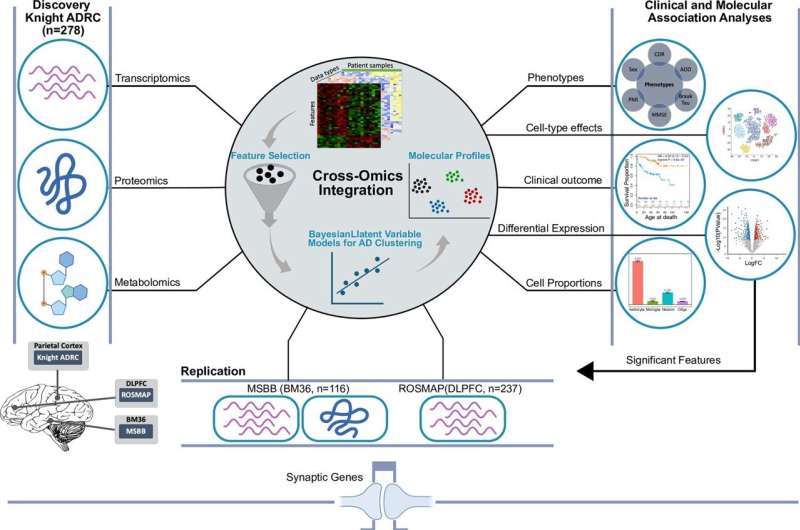This article has been reviewed according to Science X's editorial process and policies. Editors have highlighted the following attributes while ensuring the content's credibility:
fact-checked
peer-reviewed publication
trusted source
proofread
Multi-omics analysis identifies molecularly defined Alzheimer's disease subtypes

Omics analysis is the process of analyzing large data sets to extract meaningful information about biological molecules—genes, DNA, RNA, proteins, metabolites or more—with the goal of illuminating typical molecular pathways and deciphering where things go awry in disease.
In a study led by Bruno A. Benitez, MD, a human geneticist and director of the Neurobiorepository in the department of Neurology at Beth Israel Deaconess Medical Center (BIDMC), investigators used machine learning approaches to integrate high-throughput transcriptomic, proteomic, metabolomic, and lipidomic profiles to provide novel critical molecular insights into Alzheimer's Disease (AD) that single-omic analyses cannot offer. The paper is published in the journal PLOS Biology.
The cross-omics approach identified four distinct molecular profiles of AD, one of which was associated with worse cognitive function and neuropathological features, including significantly higher Clinical Dementia Rating at death, shorter lifespan after symptom onset, more severe neurodegeneration and neuroinflammation and decreased levels of metabolomic profiles.
This molecular profile was present in multiple affected cortical regions associated with more advanced disease—that is, those with more of the tau protein pathology seen in AD as well as significant dysregulation of synapse-related genes and signaling pathways altered in AD early and late stages.
The team's results suggest that cross-omics analyses can capture differences and identify molecular variations in complex and heterogeneous diseases like Alzheimer's Disease that are otherwise missed in single-modality omics approaches. By utilizing this approach, scientists can better understand this disease—and others—and pave the way for new breakthroughs and potential therapies.
Cross-omics approaches can serve as a powerful tool in investigators' efforts to understand Alzheimer's Disease, Benitez said. "These approaches are not only superior to single-omic analyses, but also provide invaluable molecular insights into the pathogenesis of this disease," he added.
"We have identified molecular markers for an early stage of the disease reflecting synaptic dysfunction, cognition, and AD staging, paving the way for precision medicine. Our research serves as a beacon of hope for those affected by AD, inspiring us to continue our relentless pursuit of knowledge and progress; we expect to replicate these findings in BIDMC patients with Alzheimer's disease."
More information: Abdallah M. Eteleeb et al, Brain high-throughput multi-omics data reveal molecular heterogeneity in Alzheimer's disease, PLOS Biology (2024). DOI: 10.1371/journal.pbio.3002607




















